Interference of Edaphoclimatic Variations on Nondestructive Parameters Measured in Standing Trees
Abstract
1. Introduction
2. Materials and Methods
2.1. Material
2.2. Region Characterization (R1 and R2)
2.3. Field Tests
2.4. Analysis of Results
3. Results and Discussion
4. Conclusions
Author Contributions
Funding
Data Availability Statement
Acknowledgments
Conflicts of Interest
References
- Câncio, O.N. Qualidade da Madeira de Eucalipto Para Produção de Celulose e sua Influência na Formação de Florestas Industriais. Master’s Thesis, Universidade Federal de Viçosa, Viçosa, Brazil, 2003. [Google Scholar]
- De Gomes, A.F. Avaliação das Características da Madeira e da Polpa de Eucalyptus Mediante a Aplicação de Métodos não Destrutivos na Árvore Viva. Master’s Thesis, Universidade Federal de Lavras, Lavras, Brazil, 2007. [Google Scholar]
- Foelkel, C. Qualidade da Madeira do Eucalipto—Reflexões Acerca da Utilização da Densidade Básica Como Indicador de Qualidade da Madeira no Setor de Base Florestal. Eucalyptus Online Book & Newsletter. Capítulo 41. 2015. Available online: https://www.eucalyptus.com.br/eucaliptos/PT41_Densidade_Basica_Madeira.pdf (accessed on 25 February 2025).
- Balasso, M.; Hunt, M.; Jacobs, A.; O’reilly-Wapstra, J. Characterization of wood quality of Eucalyptus nitens plantations and predictive models of density and stiffness with site and tree characteristics. For. Ecol. Manag. 2021, 491, 118992. [Google Scholar] [CrossRef]
- Rocha, S.M.G.; Vidaurre, G.B.; Pezzopane, J.E.M.; Almeida, M.N.F.; Carneiro, R.L.; Campoe, O.C.; Scolforo, H.F.; Alvares, C.A.A.; Neves, J.C.L.; Xavier, A.C.; et al. Influence of climatic variations on production, biomass and density of wood in eucalyptus clones of different species. For. Ecol. Manag. 2020, 473, 118290. [Google Scholar] [CrossRef]
- Almeida, M.N.F.; Vidaurre, G.B.; Pezzopane, J.E.M.; Lousada, J.L.P.C.; Silva, M.E.C.M.; Câmara, A.P.; Rocha, S.M.G.; Oliveira, J.C.L.; Campoe, O.C.; Carneiro, R.L.; et al. Heartwood variation of Eucalyptus urophylla is influenced by climatic conditions. For. Ecol. Manag. 2019, 458, 117743. [Google Scholar] [CrossRef]
- de Costa, S.E.L.; do Santos, R.C.; Vidaurre, G.B.; Castro, R.V.O.; Rocha, S.M.G.; Carneiro, R.L.; Campoe, O.C.; Santos, C.P.d.S.; Gomes, I.R.F.; de Carvalho, N.F.O.; et al. The effects of contrasting environments on the basic density and mean annual increment of wood from eucalyptus clones. For. Ecol. Manag. 2019, 458, 117807. [Google Scholar] [CrossRef]
- Câmara, A.P.; Vidaurre, G.B.; Oliveira, J.C.L.; de Picoli, E.A.T.; Almeida, M.N.F.; Roque, R.M.; Tomazello Filho, M.; Souza, H.J.P.; Oliveira, T.R.; Campoe, O.C. Changes in hydraulic architecture across a water availability gradient for two contrasting commercial Eucalyptus clones. For. Ecol. Manag. 2020, 474, 118380. [Google Scholar] [CrossRef]
- Câmara, A.P.; Vidaurre, G.B.; Oliveira, J.C.L.; Teodoro, P.E.; Almeida, M.N.F.; Toledo, J.V.; Dias Júnior, A.F.; Amorim, G.A.; Pezzopane, J.E.M.; Campoe, O.C. Changes in rainfall patterns enhance the interrelationships between climate and wood traits of eucalyptus. For. Ecol. Manag. 2021, 485, 118959. [Google Scholar] [CrossRef]
- Pellerin, R.F.; Ross, R.J. Nondestructive Evaluation of Wood, 2nd ed.; Forest Products Society: Madison, WI, USA, 2002. [Google Scholar]
- Oliveira, F.R.; Campos, J.A.O.; Sales, A. Ultrasonic measurements in Brazilian hardwood. Mater. Res. 2002, 5, 51–55. [Google Scholar] [CrossRef]
- Brashaw, B.K.; Bucur, V.; Divos, F.; Gonçalves, R.; Lu, J.; Meder, R.; Pellerin, R.F.; Potter, S.; Ross, R.J.; Wang, X.; et al. Nondestructive Testing and Evaluation of Wood: A worldwide research update. For. Prod. J. 2009, 59, 7–14. [Google Scholar]
- Elissetche, J.P.; Alzamora, R.M.; Espinoza, Y.; Emhart, V.; Pincheira, M.; Medina, A.; Rubilar, R. Wood basic density assessment of Eucalyptus genotypes growing under contrasting water availability conditions. Forests 2024, 15, 185. [Google Scholar] [CrossRef]
- Kravetz, C.; Bertoldo, C.; Lorensani, R.M.; Guedes, F.T.P. Influence of edaphoclimatic variations on growth and non-destructive parameters obtained in Eucalyptus sp. Clone trees. In Proceedings of the 23rd International Nondestructive Testing and Evaluation of Wood Symposium, Campinas, Brazil, 17–21 September 2024. [Google Scholar]
- Gendvilas, V.; Downes, G.M.; Neyland, M.; Hunt, M.; Harrison, P.A.; Jacobs, A.; Williams, D.; O’reilly-Wapstra, J. Thinning influences wood properties of plantation-grown Eucalyptus nitens at three sites in tasmânia. Forests 2021, 12, 1304. [Google Scholar] [CrossRef]
- Mascarenhas, A.R.P.; de Oliveira Corrêa, F.L.; de Melo, R.R.; Sccoti, M.S.V.; de Souza, E.F.M.; Araujo, E.C.G.; Silva, T.C. Uso do Pilodyn para estimativa das propriedades físicas de madeiras produzidas em sistema agroflorestal. In Proceedings of the Anais do VII Workshop de Informação, Dados e Tecnologia, Porto Velho, Brazil, 25–27 June 2024. [Google Scholar]
- Ferreira, M.D.; de Melo, R.R.; Tonini, H.; Stangerlin, D.M.; Beltrame, R.; Gatto, D.A.; Mascarenhas, A.R.P. Growth, production and wood quality in integrated crop-livestock-forest and monoculture systems. Rev. Bras. Ciênc. Agrár. 2020, 15, e7928. [Google Scholar] [CrossRef]
- de Gouvêa, A.G.; Trugilho, P.F.; Gomide, J.L.; da Silva, J.R.M.; Andrade, C.R.; Alves, I.C.N. Determinação da densidade básica da madeira de eucalyptus por diferentes métodos não destrutivos. Rev. Árvore 2011, 35, 349–358. [Google Scholar] [CrossRef]
- Lorensani, R.M.; Palma, S.S.A.; Gonçalves, R. Machine learning algorithms and non-destructive methods for inference properties of planted forest trees. In Proceedings of the 23rd International Nondestructive Testing and Evaluation of Wood Symposium, Campinas, Brazil, 17–21 September 2024. [Google Scholar]
- Gonçalves, R.; LorensanI, R.G.M.; Ruy, M.; Veiga, N.S.; Muller, G.; da Alves, C.S.; Martins, G.A. Evolution of acoustical, geometrical, physical, and mechanical parameters from seedling to cutting age in Eucalyptus clones used in the pulp and paper industries in Brazil. For. Prod. J. 2019, 69, 5–16. [Google Scholar] [CrossRef]
- Rinn, F.; Schweingruber, F.H.; Schar, E. Resistograph and X-ray density charts of wood comparative evaluation of drill resistance profiles and X-ray density charts of different wood species. Holzforschung 1996, 50, 303–311. [Google Scholar] [CrossRef]
- Hansen, C.P. Application of the Pilodyn in Forest Tree Improvement; Series of Technical Notes, 55; DANIDA Forest Seed Centre: Humlebaek, Denmark, 2000. [Google Scholar]
- Lima, J.T.; Hein, P.R.G.; Trugilho, P.F.; da Silva, J.R.M. Adequação do Resistograph® para a estimativa da densidade básica da madeira de Eucalyptus. Rev. Madeira Arquitetura Eng. 2006, 18, 12. [Google Scholar]
- Gonçalves, F.G.; da Oliveira, J.T.S.; Tomazello Filho, M.; Rezende, G.D.S.P. Estimativa da densidade básica da madeira de um híbrido clonal de Eucalyptus urophylla × Eucalyptus grandis por método não destrutivo. Rev. Cerne 2007, 13, 119–128. [Google Scholar]
- Wang, X.; Ross, R.J.; Carter, P. Acoustic Evaluation of Wood Quality in Standing Trees. Part 1. Acoustic Wave Behavior. Wood Sci. Technol. 2007, 39, 28–38. [Google Scholar]
- Bertoldo, C.; Gonçalves, R.; Massak, M.V.; Secco, C. Assessment of Wood Quality by Tree Evaluation Using Ultrasound. In Proceedings of the XIII Congresso Florestal Mundial, Buenos Aires, Argentina, 18–23 October 2009. [Google Scholar]
- Bertoldo, C.; Gonçalves, R.; Batista, F.; Secco, C.B. Velocity of ultrasonic waves in live trees and in freshly-felled logs. In Proceedings of the 17th International Nondestructive Testing and Evaluation of Wood Symposium, Sopron, Hungary, 14–16 September 2011. [Google Scholar]
- Batista, F.A.F. Diferenciação de Clones de Eucalipto Utilizando Ensaio de Propagação de Ondas em Árvores. Master’s Thesis, Faculdade de Engenharia Agrícola, Universidade Estadual de Campinas, Campinas, Brazil, 2012. (In Portuguese with English Abstract). [Google Scholar]
- Wang, X. Acoustic Measurements on Trees and Logs: A Review and Analysis. Wood Sci. Technol. 2013, 47, 965–975. [Google Scholar] [CrossRef]
- Chan, J.M.; Walker, J.C.; Raymond, C.A. Effects of moisture content and temperature on acoustic velocity and dynamic MOE of radiata pine sapwood boards. Wood Sci. Technol. 2011, 45, 609–626. [Google Scholar] [CrossRef]
- Gao, S.; Wang, X.; Wang, L.; Allison, R.B. Effect of temperature on acoustic evaluation of standing trees and longs: Part 2: Field investigation. Wood Fiber Sci. 2013, 45, 15–25. [Google Scholar]
- Flores, T.B.; Alvares, C.A.; Souza, V.C.; Stape, J.L. Eucalyptus no Brasil—Zoneamento Climático e Guia Para Identificação, 1st ed.; IPEF—Instituto de Pesquisas e Estudos Florestais: Piracicaba, Brazil, 2016; 448p. [Google Scholar]
- Lepsh, I.F. 19 Lições de Pedologia; Oficina de Textos: São Paulo, Brazil, 2011. [Google Scholar]
- Isik, F.; Li, B.L. Rapid assessment of wood density of live trees using the Resistograph for selection in tree improvement programs. Can. J. For. Res. 2003, 33, 2426–2435. [Google Scholar] [CrossRef]
- Duong, D.V.; Hasegawa, M.; Matsumura, J. The relations of fiber length, wood density, and compressive strength to ultrasonic wave velocity within stem of Melia azedarach. Indian Acad. Wood Sci. 2018, 16, 1–8. [Google Scholar]
- Vidaurre, G.B.; da Silva, J.G.M.; Moulin, J.C.; de Carneiro, A.C.O. Qualidade da Madeira de Eucalipto Proveniente de Plantações no Brasil; EDUFES: Vitória, Brazil, 2020; 221p. [Google Scholar]
- Bucur, V. Acoustics of Wood, 2nd ed.; Springer: Berlin/Heidelberg, Germany, 2006. [Google Scholar]
- Peña, J.; Grace, J. Water relations and ultrasound emissions of Pinus sylvestris L. before, during and after a period of water stress. New Phytol. 1986, 103, 515–524. [Google Scholar] [CrossRef]
- Oliveira, F.G.R.; Sales, A.; Lucchette, F.F.; Candian, M. Efeito do comprimento do corpo de prova na velocidade ultrassônica em madeiras (Effect of specimen length on ultrasonic velocity of wood). Rev. Árvore 2006, 30, 141–145. [Google Scholar] [CrossRef]
- Trinca, A.J.; Gonçalves, R. Efeito das dimensões da seção transversal e da frequência do transdutor na velocidade de propagação de ondas de ultra-som na Madeira. Rev. Arvore 2009, 33, 177–184. [Google Scholar] [CrossRef]
- Stackpole, D.J.; Vaillancourt, R.E.; de Aguigar, M.; Potts, B.M. Age trends in genetic parameters for growth and wood density in Eucalyptus globulus. Tree Genet. Genomes 2010, 6, 179–193. [Google Scholar] [CrossRef]
- Soriano, J.; Gonçalves, R.; Bertoldo, C.; Trinca, A.J. Aplicações do método de ensaio esclerométrico em peças de eucalipto saligna sm. Rev. Bras. Eng. Agríc. Ambient. 2011, 15, 322–328. [Google Scholar] [CrossRef]
- Dewi, A.P.; Tihurua, E.F.; Wulansari, T.Y.I. Trachea features and fiber dimensions of fast-growing tree: A case study on wood samples from eastern Indonesia. IOP Conf. Ser. Earth Environ. Sci. 2022, 976, 012063. [Google Scholar] [CrossRef]
- Nguyen, H.; Firn, J.; Lamb, D.; Herbohn, J. Wood density: A tool to find complementary species for the design of mix species plantations. For. Ecol. Manag. 2014, 334, 106–113. [Google Scholar] [CrossRef]
- Zobel, B.J.; Buijtenen, J.P. Wood Variation: Its Causes and Control; Spring Series in Wood Science; Springer: Berlin/Heidelberg, Germany, 1989; 363p. [Google Scholar]

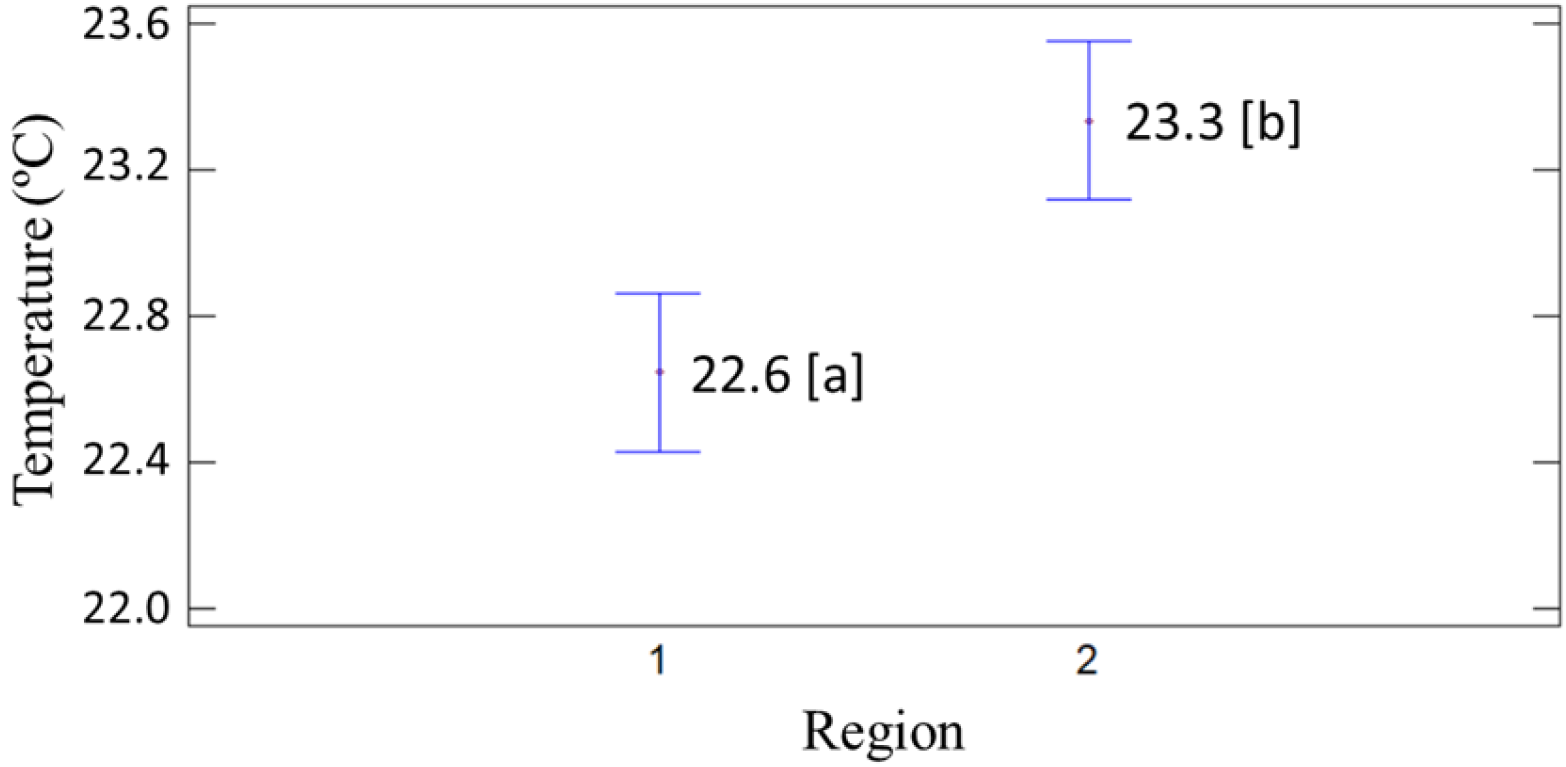

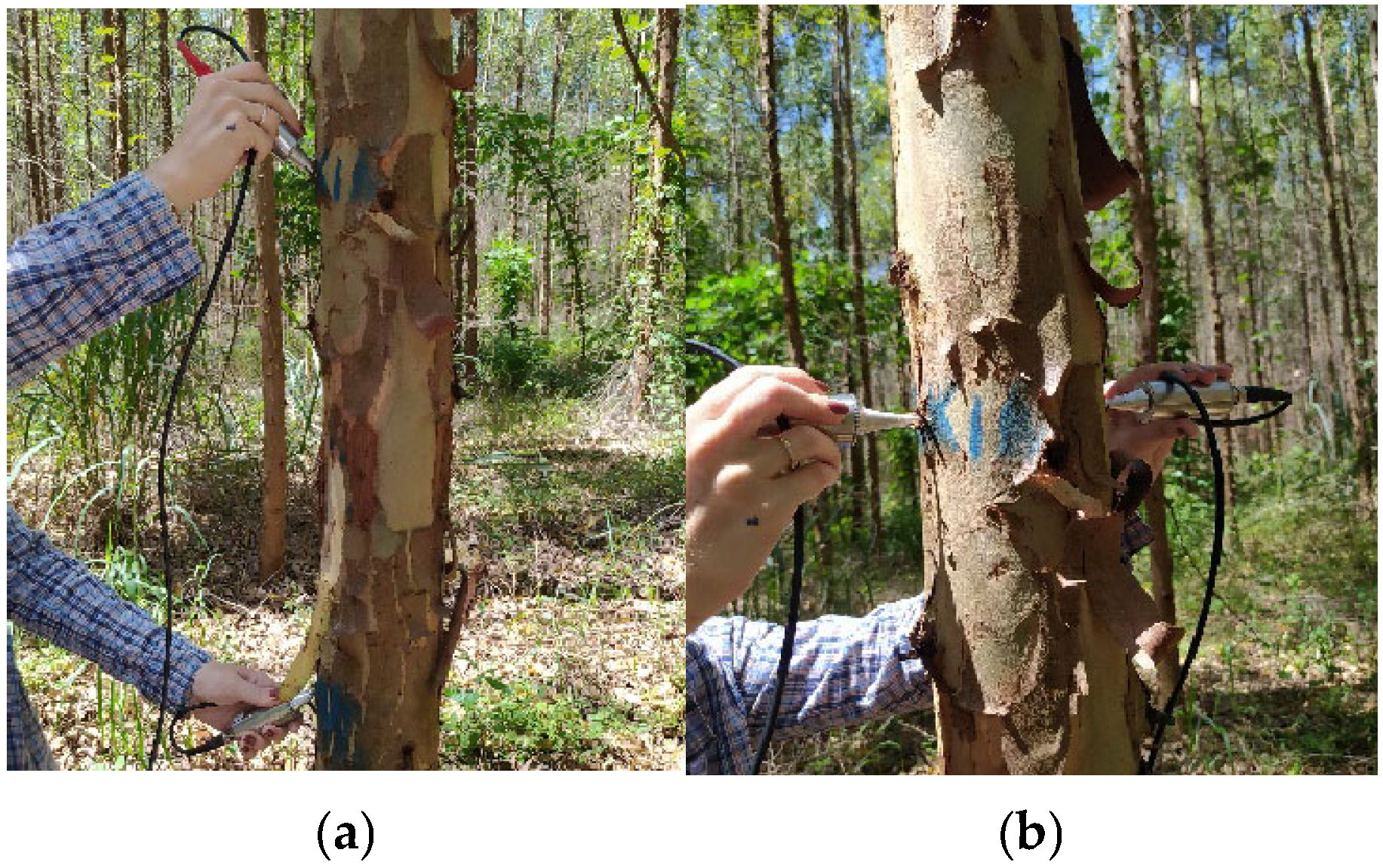
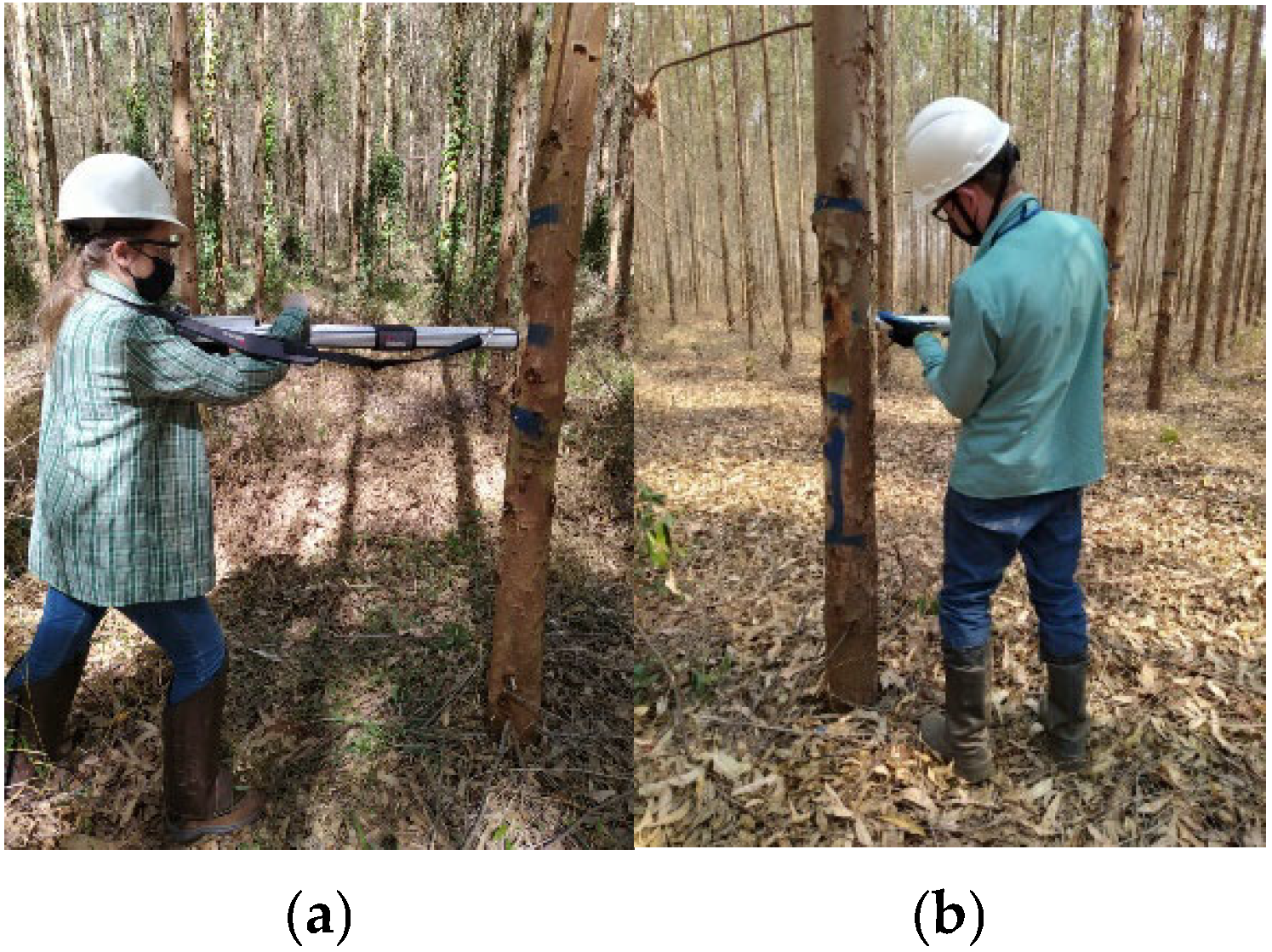
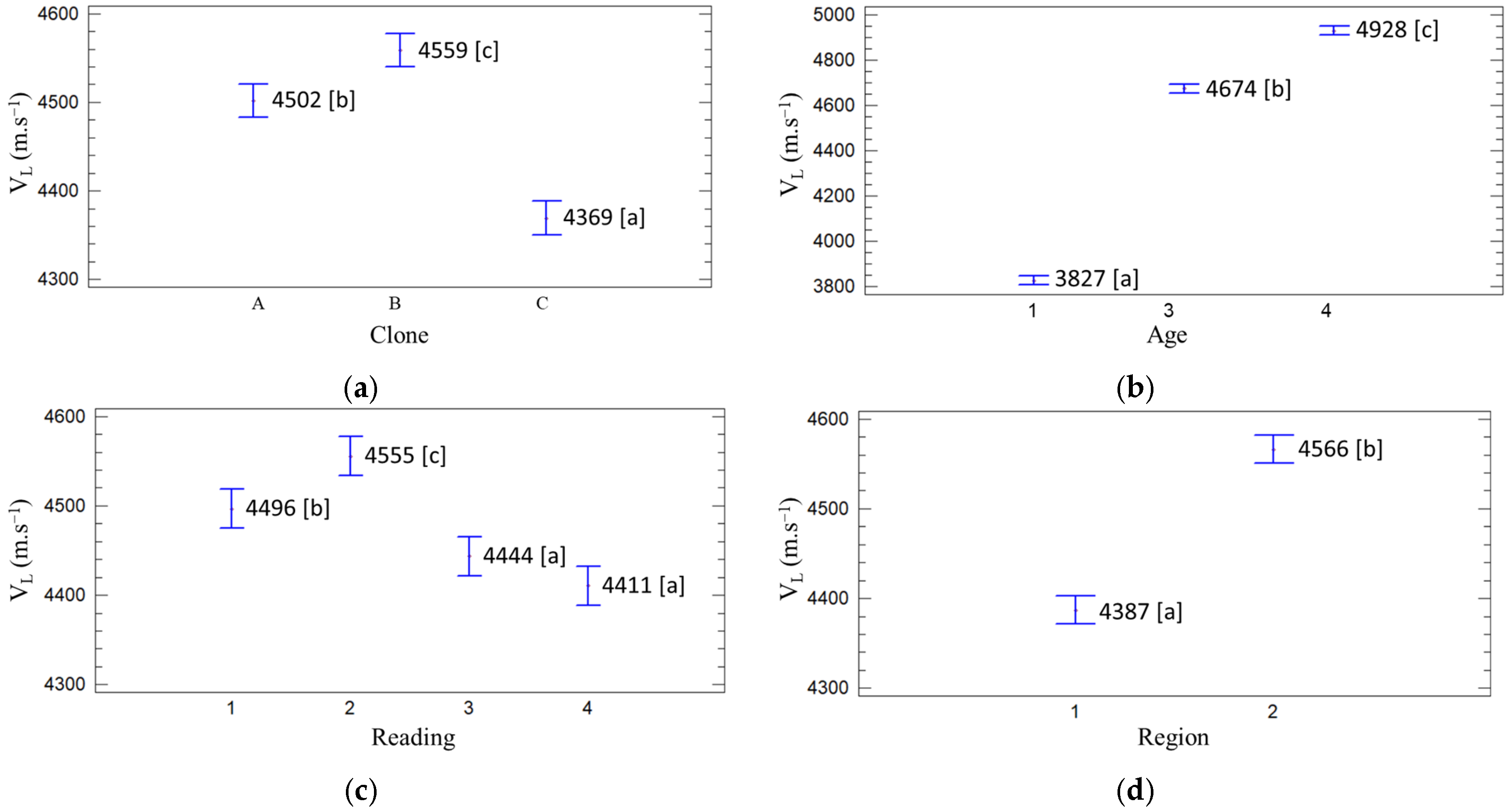
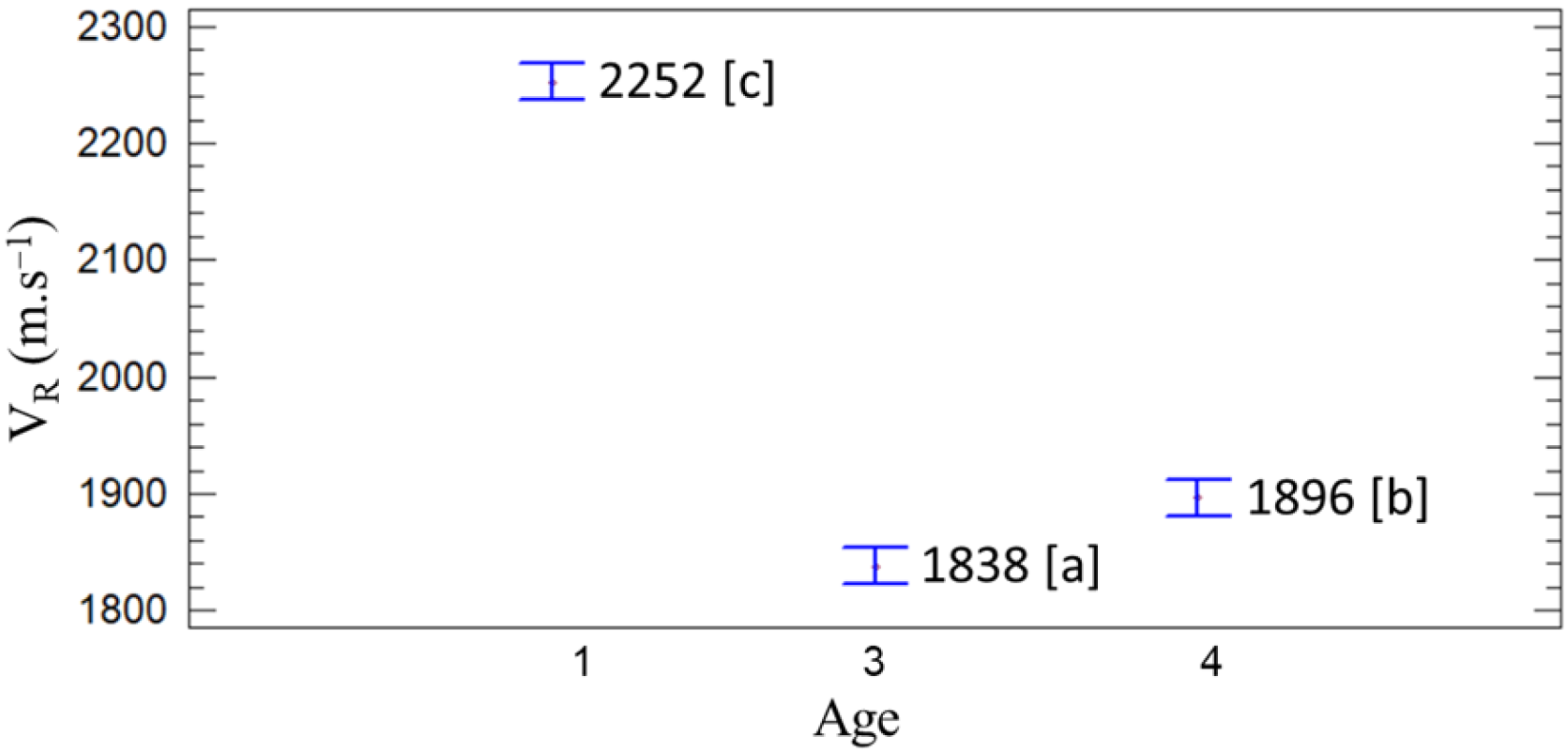

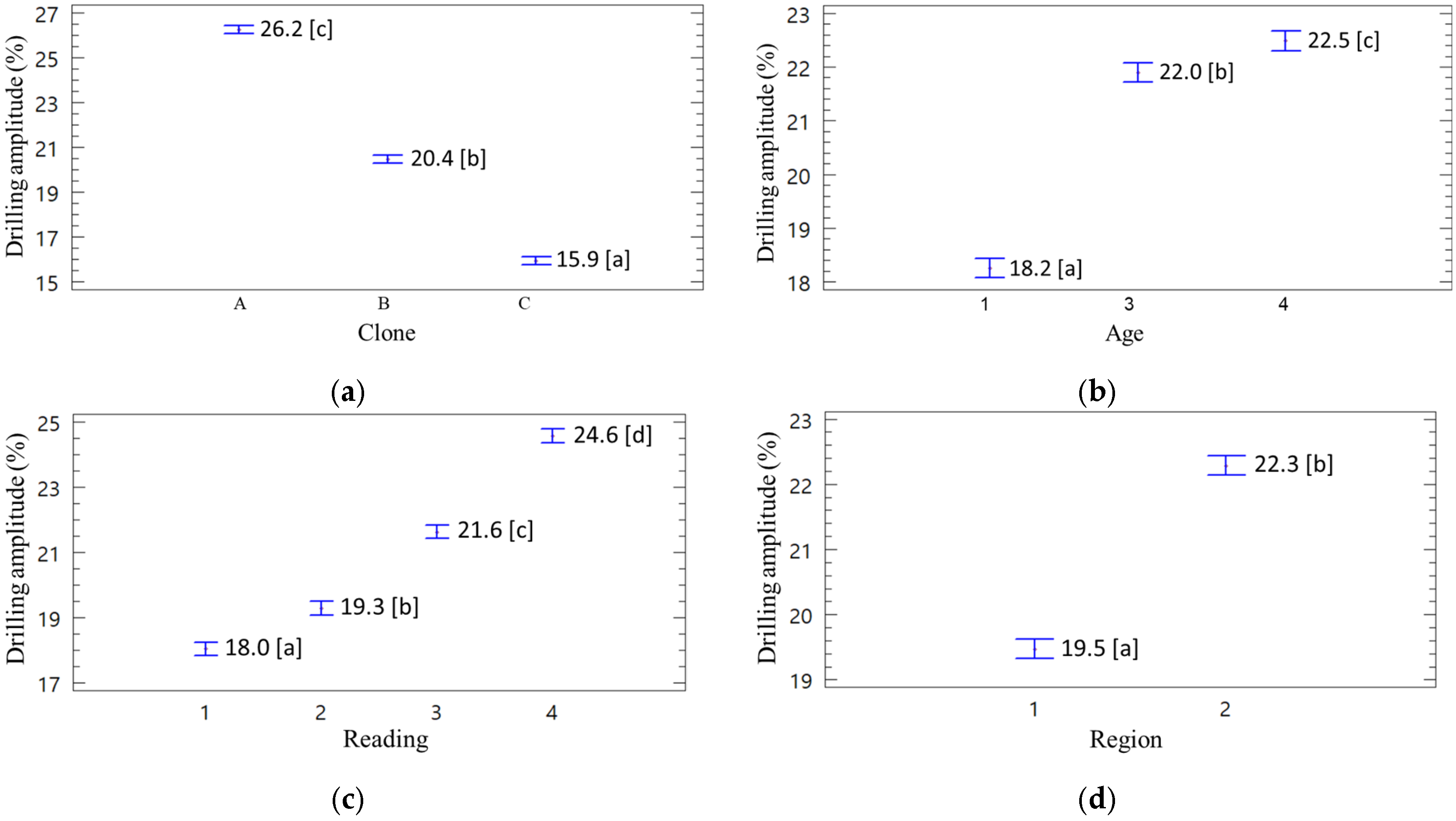
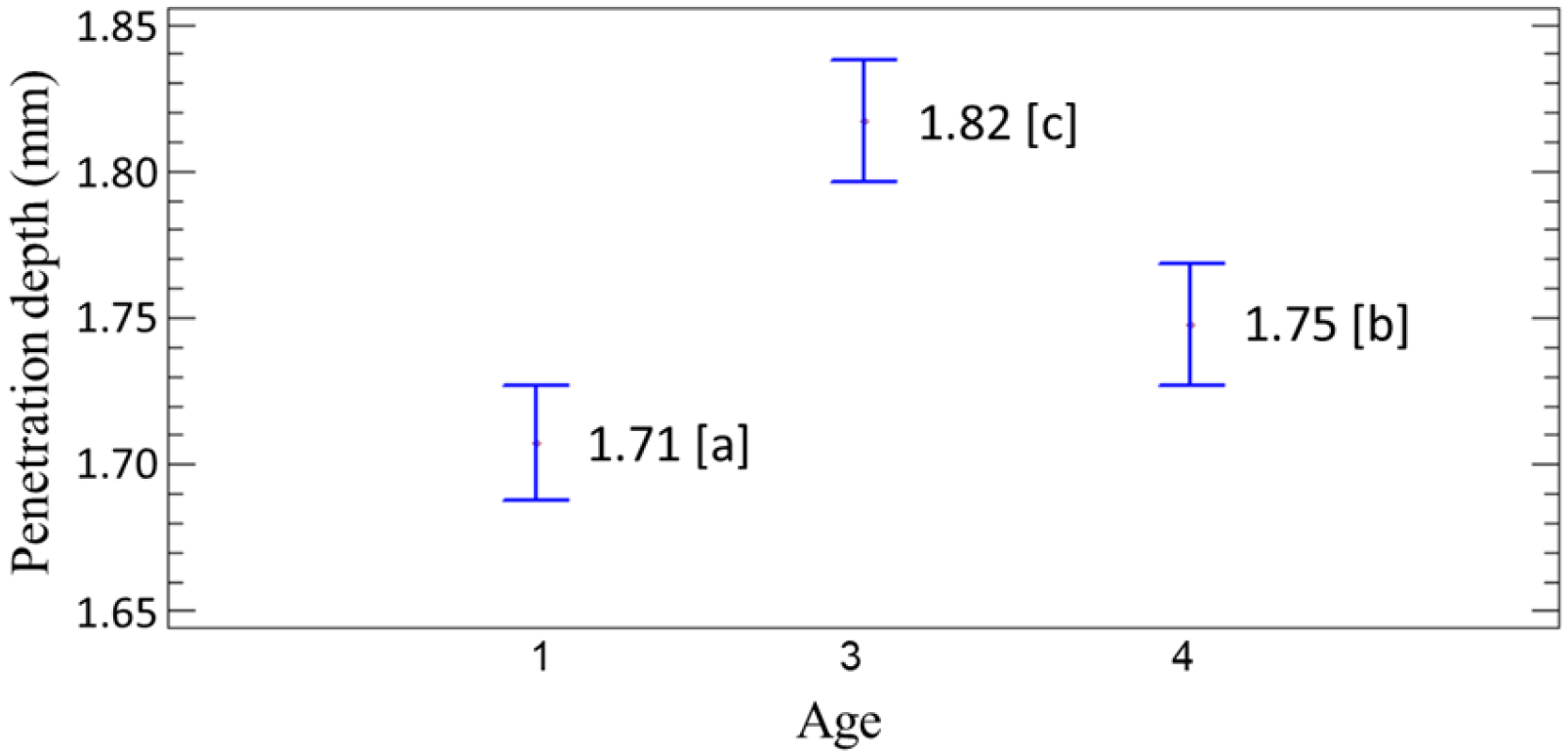
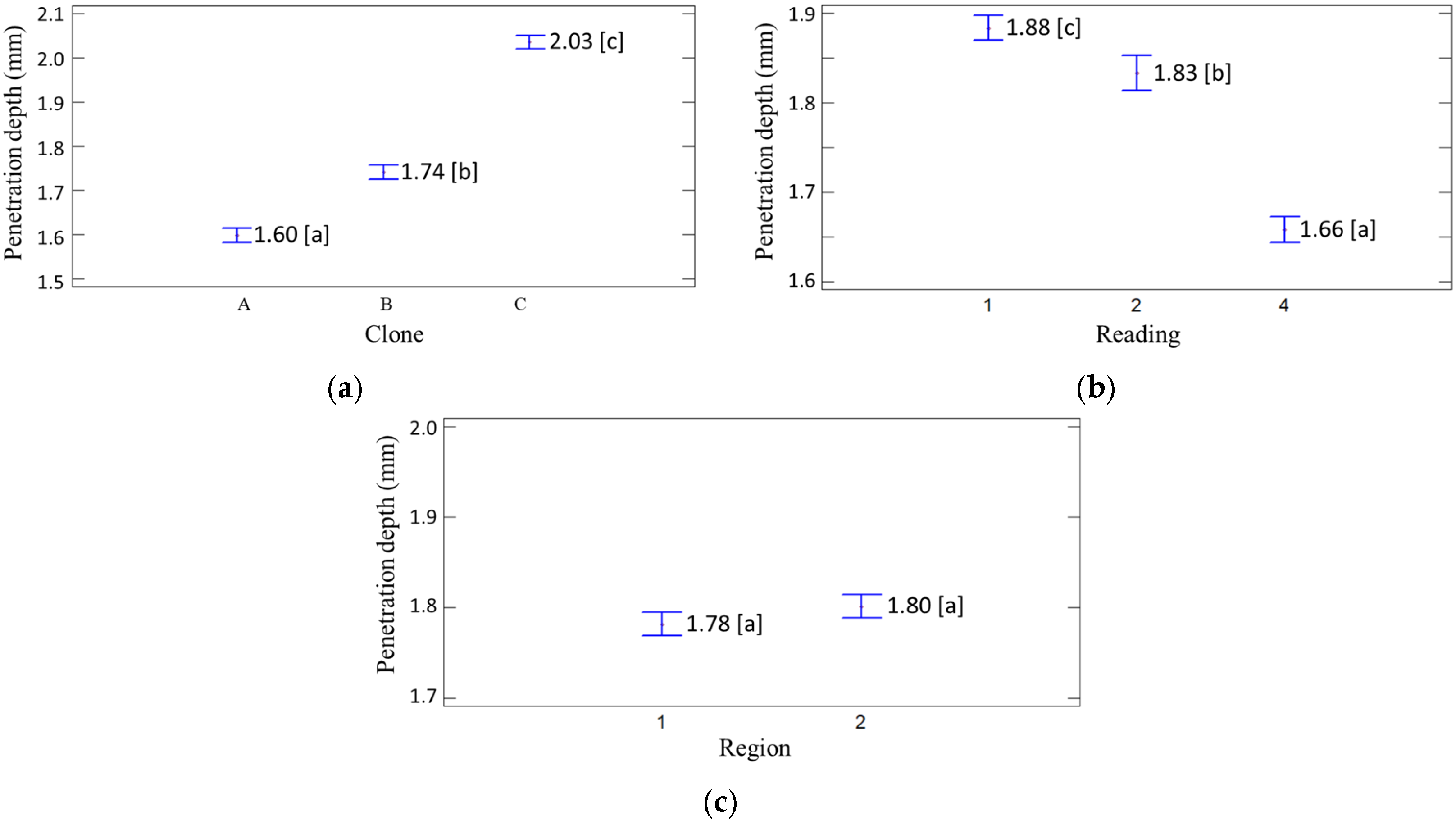



| Parameter | p-Value |
|---|---|
| Mean temperature | 0.01 |
| Monthly accumulated precipitation | 0.06 |
| Global radiation | 0.31 |
| Pressure deficit | 0.06 |
| Actual evapotranspiration | 0.13 |
| Soil water storage | 0.01 |
| Water deficit | 0.28 |
| Age (Years) | Clone—R1 | Clone—R2 | ||||||
|---|---|---|---|---|---|---|---|---|
| A | B | C | Mean | A | B | C | Mean | |
| 1 | −8.9% | −6.3% | −4.1% | −6.4% | −7.1% | −4.5% | 5.6% | −2.0% |
| 3 | 4.5% | 7.1% | 7.9% | 6.5% | 7.1% | 4.1% | 7.3% | 6.2% |
| 4 | 3.4% | 11.1% | 9.6% | 8.0% | 16.5% | 13.8% | 13.0% | 14.4% |
| Mean | 3.9% | 9.1% | 8.7% | 7.3% * | 11.8% | 8.9% | 10.2% | 10.3% * |
| Age (Years) | Clone—R1 | Clone—R2 | ||||||
|---|---|---|---|---|---|---|---|---|
| A | B | C | Mean | A | B | C | Mean | |
| 1 | 23.4% | 14.8% | 18.6% | 18.9% | 18.4% | 7.2% | 9.2% | 11.6% |
| 3 | 12.8% | 9.8% | 16.1% | 12.9% | 13.1% | 1.0% | 12.7% | 8.9% |
| 4 | 6.8% | 18.2% | 11.6% | 12.2% | 13.3% | 16.1% | 8.8% | 12.7% |
| Mean | 14.4% | 14.3% | 15.4% | 14.7% | 14.9% | 8.1% | 10.2% | 11.1% |
Disclaimer/Publisher’s Note: The statements, opinions and data contained in all publications are solely those of the individual author(s) and contributor(s) and not of MDPI and/or the editor(s). MDPI and/or the editor(s) disclaim responsibility for any injury to people or property resulting from any ideas, methods, instructions or products referred to in the content. |
© 2025 by the authors. Licensee MDPI, Basel, Switzerland. This article is an open access article distributed under the terms and conditions of the Creative Commons Attribution (CC BY) license (https://creativecommons.org/licenses/by/4.0/).
Share and Cite
Kravetz, C.; Bertoldo, C.; Lorensani, R.; Ferreira, K. Interference of Edaphoclimatic Variations on Nondestructive Parameters Measured in Standing Trees. Forests 2025, 16, 535. https://doi.org/10.3390/f16030535
Kravetz C, Bertoldo C, Lorensani R, Ferreira K. Interference of Edaphoclimatic Variations on Nondestructive Parameters Measured in Standing Trees. Forests. 2025; 16(3):535. https://doi.org/10.3390/f16030535
Chicago/Turabian StyleKravetz, Carolina, Cinthya Bertoldo, Rafael Lorensani, and Karina Ferreira. 2025. "Interference of Edaphoclimatic Variations on Nondestructive Parameters Measured in Standing Trees" Forests 16, no. 3: 535. https://doi.org/10.3390/f16030535
APA StyleKravetz, C., Bertoldo, C., Lorensani, R., & Ferreira, K. (2025). Interference of Edaphoclimatic Variations on Nondestructive Parameters Measured in Standing Trees. Forests, 16(3), 535. https://doi.org/10.3390/f16030535






